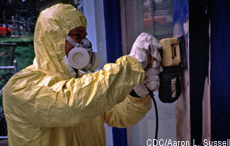 |
 |
 |
Other Health Topics:

-
Related Topics
-
Go Local
- Services and providers for Lead Poisoning in the U.S.
-
National Institutes of Health
- The primary NIH organization for research on Lead Poisoning is the National Institute of Environmental Health Sciences
Languages
Lead is a metal that occurs naturally in the earth's crust. People have spread it through the environment in many ways. Lead used to be in paint and gasoline. Lead can still be found in contaminated soil, household dust, drinking water, lead-glazed pottery and some metal jewelry.
Breathing air, drinking water, eating food or swallowing or touching dirt that contains lead can cause many health problems. In adults, lead can increase blood pressure and cause infertility, nerve disorders and muscle and joint pain. It can also make you irritable and affect your ability to concentrate and remember.
Lead is especially dangerous for children. A child who swallows large amounts of lead may develop anemia, severe stomachache, muscle weakness and brain damage. Even low levels of lead are linked to lower IQ scores.
Centers for Disease Control and Prevention
- Human Exposure to Environmental Chemicals: Lead(Centers for Disease Control and Prevention) - Links to PDF
-
Lead(Agency for Toxic Substances and Disease Registry)
Also available in Spanish
-
Lead and Your Health
 (National Institute of Environmental Health Sciences) - Links to PDF
(National Institute of Environmental Health Sciences) - Links to PDF
| Basics | Learn More | Multimedia & Cool Tools |
|---|---|---|
| Research | Reference Shelf | For You |
-
Overviews
- Lead in Paint, Dust, and Soil(Environmental Protection Agency, Office of Prevention, Pesticides and Toxic Substances)
- Lead Poisoning(Mayo Foundation for Medical Education and Research)
-
Tox Town
 (National Library of Medicine)
(National Library of Medicine)
Also available in Spanish
-
Latest News
- Home Renovations by Affluent Families Can Unleash Lead Threat(01/29/2009, HealthDay)
-
Diagnosis/Symptoms
- Blood Test: Lead(Nemours Foundation)
- FDA Broadens Access to Lead Screening Test(Food and Drug Administration)
- Lead Test(American Association for Clinical Chemistry)
-
Prevention/Screening
- Humans and Lead Fishing Sinkers(Environmental Protection Agency, Office of Water)
- Is There Lead in My Drinking Water?(Environmental Protection Agency, Office of Water)
- Kohl, Kajal, Al-Kahl, or Surma: By Any Name, Beware of Lead Poisoning(Center for Food Safety and Applied Nutrition)
-
Reducing Lead Hazards When Remodeling Your Home(Environmental Protection Agency, Office of Prevention, Pesticides and Toxic Substances) - Links to PDF
Also available in Spanish
- Testing Your Home for Lead in Paint, Dust, and Soil(Environmental Protection Agency) - Large PDF file
-
Specific Conditions
- Introduction to Indoor Air Quality: Lead (Pb)(Environmental Protection Agency, Indoor Environments Division)
-
Related Issues
- Lead (in the Workplace)(Occupational Safety and Health Administration)
- Lead and Drinking Water from Private Wells(Centers for Disease Control and Prevention)
- Lead Recalls(Centers for Disease Control and Prevention)
-
Videos
-
Lead Poisoning in Children(Healthy Roads Media)
Also available in Spanish
- Lead Webcast for the Community(Agency for Toxic Substances and Disease Registry)
-
Lead Poisoning in Children(Healthy Roads Media)
-
Clinical Trials
-
ClinicalTrials.gov: Lead Poisoning
 (National Institutes of Health)
(National Institutes of Health)
-
ClinicalTrials.gov: Lead Poisoning
-
Journal Articles
References and abstracts from MEDLINE/PubMed (National Library of Medicine)
- Article: Lead outreach needs for the State of Arkansas.
- Article: The effect of plasma lead on anembryonic pregnancy.
- Article: Lead in housing paints: an exposure source still not taken...
- Lead Poisoning -- see more articles
-
Dictionaries/Glossaries
- Understanding Lead Terminology(National Safety Council)
-
Directories
- Lead-Related Information: Federal, State and Local Government Contacts(National Safety Council)
- Toxics Release Inventory (TRI) Program(Environmental Protection Agency)
-
Organizations
- Environmental Protection Agency
- National Center for Environmental Health(Centers for Disease Control and Prevention)
- National Center for Healthy Housing
-
National Institute of Environmental Health Sciences

Also available in Spanish
-
Law and Policy
- Real Estate Lead Disclosure Requirements(National Safety Council)
-
Statistics
-
TOXMAP
 (National Library of Medicine) - Create maps showing locations of toxic chemical releases
(National Library of Medicine) - Create maps showing locations of toxic chemical releases
-
TOXMAP
-
Children
-
Adventures of the Lead Busters Club
 (National Institute of Environmental Health Sciences)
(National Institute of Environmental Health Sciences)
Also available in Spanish
- Childhood Lead Exposure(Centers for Disease Control and Prevention)
-
Lead Poisoning in Children
 (Healthy Roads Media)
(Healthy Roads Media)
Also available in Spanish
-
Lead Poisoning Kids' Page
 (National Institute of Environmental Health Sciences)
(National Institute of Environmental Health Sciences)
-
Ten Tips to Protect Children from Pesticide and Lead Poisonings(Environmental Protection Agency, Office of Pesticide Programs)
Also available in Spanish
-
Adventures of the Lead Busters Club
| Home | Health Topics | Drugs & Supplements | Encyclopedia | Dictionary | News | Directories | Other Resources | |
| Disclaimers | Copyright | Privacy | Accessibility | Quality Guidelines U.S. National Library of Medicine, 8600 Rockville Pike, Bethesda, MD 20894 National Institutes of Health | Department of Health & Human Services |
Date last updated: 30 January 2009 Topic last reviewed: 09 October 2008 |






